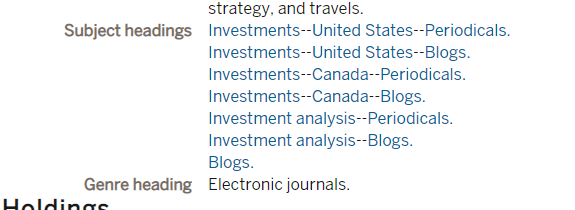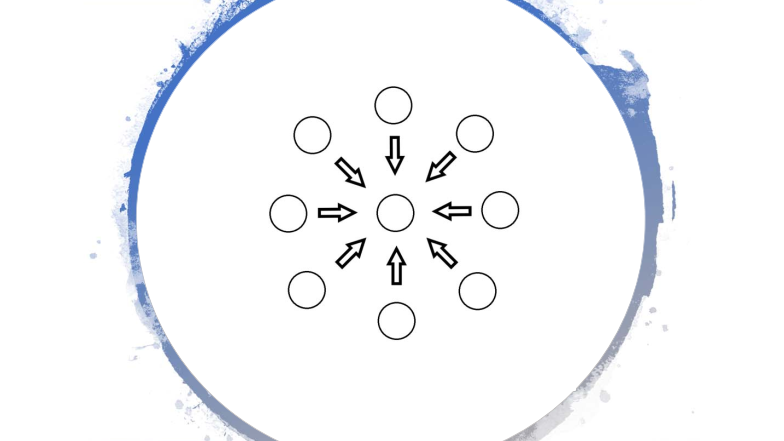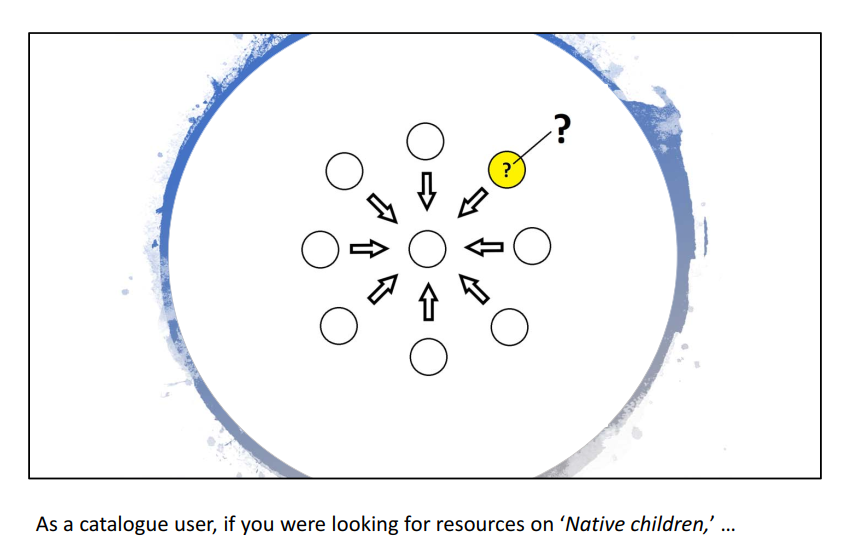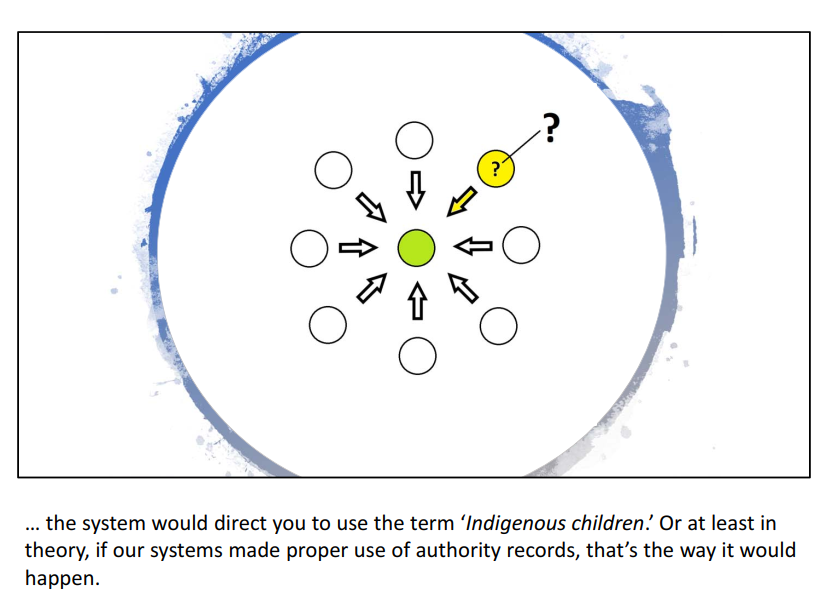As discussed in the previous entry, three basic rules that occur in thesauri are UF BT/NT and RT.
- Use/Use For (USE/UF),
- Broader Terms and Narrower Terms (BT/NT), and
- Related Terms (RT).
USE/UF
According to the Library of Congress:
USE references are made from an unauthorized or non-preferred term to an authorized or preferred heading. Under the heading referred to, the code UF (Used For) precedes the term not used… USE references are made from an unauthorized or non-preferred term to an authorized or preferred heading. Under the heading referred to, the code UF (Used For) precedes the term not used. The codes USE and UF function as reciprocals
This is the strictest of all the rules in a thesaurus. It tells the cataloger to use one word in place of another (USE FOR), or that the material that they are looking for is under a different term (USE).
LC’s example is
Cars (Automobiles)
USE Automobiles
Automobiles
UF Cars (Automobiles)
However, LC also notes
USE references are made from synonyms, variant spellings, variant forms of expression, alternate constructions of headings, and earlier forms of headings. USE references are also made when it has been decided that words should not be used as a heading even if the heading and the unused words are not truly synonymous.
These sorts of explanations often key a more experienced reader of catalogs into some sort of tension within the system. A rather infamous example is the Library of Congress Subject Heading Cross-dressers, which is defined by
Here are entered works on persons, especially males, who assume the dress and manner of the opposite sex for psychological gratification.
Works on men who impersonate women, generally for purposes of entertainment or comic effect, are entered under [Female impersonators.] Works on women who impersonate men, generally for purposes of entertainment or comic effect, are entered under [Male impersonators.]
For any reader vaguely familiar with one of the various cross-dressing/drag/etc reality TV shows like RuPaul’s Drag Race, it’s very clear how little sense this term makes. 1
BT and NT
According to LC, the abbreviations BT and NT indicate classification hiararchy.
The code BT precedes a subject heading representing, according to current policy, the class of which the heading is a member. The code NT precedes a subject heading representing, in most cases, a member of the class represented by the heading under which the NT appears.
This is a rather convoluted explanation, but the simpler explanation is that they indicate hierarchy. The broadest (parent) terms tend to be incredibly vague ideas, like “Art”, which then generally need to be narrowed down more to be useful, so it will have muliple NTs, or narrower terms, such as
Art
NT Western Art
NT Indigenous Art
NT Asian Art
NT etc.
These NTs will often have further NTs, so Western Art -> Western Sculpture -> Modern Sculpture (and so on).
You can see this in library catalogs today. Here’s an example from Indiana University’s IUCAT for “Adventures in Capitalism”:

Image Description: the “Subject Headings” section of the previous link.
In this case, “Blogs” is the NT of “Investments, United States” but also of “Investments, Canada” and “Investment Analysis.”
RT
According to LC,
The associative relationship, expressed by the code RT meaning Related Term, links two headings that are associated in some manner other than by hierarchy. For example,
Birds
RT Ornithology
Ornithology
RT Birds
In the most basic sense, RTs just assert that there are connections between the current subject term and another one. For a cataloger, this enable them to consider connected terms to catalog their material under. For a user, this allows them to check under both subject headings to ensure that they have reviewed all of the relevant information.
RTs allow information institutions to control terminology—to explain this, I borrow this image from F. Tim Knight’s stupendous presentation Worldviews, Term Circles, Linked Data

As Knight explains:
Pictured here is one way to illustrate the mutually exclusive relationship between terms in LC subject headings. In the centre is the “preferred term” and surrounding it are the so‐called ‘used for’ terms. The idea is that by providing only one term per subject or concept a more consistent, or “universal,” approach to information organization can be provided.


To draw from & (finally) turn to the Thesaurus in question, let’s look at an example from the Kinsey’s Sexual Nomenclature: A Thesaurus:
Absent father effects
(May be subdivided by sex.)
BT Adolescent behavior
BT Child behavior
RT Child parent relationships
RT Homosexuality etiology
RT Single parents
NOTE: Studies of effects on children of absent fathers.
What, you may be asking, does an absent father have to do with homosexuality?? Well, next time we will discuss it!
(cover image is of SNT’s spine, which reads Sexual Nomenclature: A Thesaurus. Copyright is held by the Kinsey Institute Library and Special Collections. )
Citations
- Aitchison, Jean, and Stella Dextre Clarke. 2004. “The Thesaurus: A Historical Viewpoint, with a Look to the Future.” Cataloging & Classification Quarterly 37 (3–4): 5–21. https://doi.org/10.1300/J104v37n03_02.
- Carlson, Scott, and Amber Seely. 2017. “Using OpenRefine’s Reconciliation to Validate Local Authority Headings.” Cataloging & Classification Quarterly 55 (1): 1–11. https://doi.org/10.1080/01639374.2016.1245693.
- Greenberg, Jane. 2004. “User Comprehension and Searching with Information Retrieval Thesauri.” Cataloging & Classification Quarterly 37 (3–4): 103–20. https://doi.org/10.1300/J104v37n03_08.
- Library of Congress, Library of Congress, Subject Cataloging Division, Library of Congress, Office for Subject Cataloging Policy, Library of Congress, Cataloging Policy and Support Office, Library of Congress, and Policy and Standards Division. 2019. “Introduction.” In Library of Congress Subject Headings, 41st ed., vii–xiv. Washington, D.C: Library of Congress.
- Nielsen, Marianne Lykke. 2004. “Thesaurus Construction: Key Issues and Selected Readings.” Cataloging & Classification Quarterly 37 (3–4): 57–74. https://doi.org/10.1300/J104v37n03_05.
- Owens, Leslie Ann, and Pauline Atherton Cochrane. 2004. “Thesaurus Evaluation.” Cataloging & Classification Quarterly 37 (3–4): 87–102. https://doi.org/10.1300/J104v37n03_07.
- Rolland-Thomas, Paule. 1993. “Thesaural Codes: An Appraisal of Their Use in the Library of Congress Subject Headings.” Cataloging & Classification Quarterly 16 (2): 71–91. https://doi.org/10.1300/J104v16n02_05.
- Shearer, James R. 2004. “A Practical Exercise in Building a Thesaurus.” Cataloging & Classification Quarterly 37 (3–4): 35–56. https://doi.org/10.1300/J104v37n03_04.
- Thomas, Alan R. 2004. “Teach Yourself Thesaurus: Exercises, Readings, Resources.” Cataloging & Classification Quarterly 37 (3–4): 23–34. https://doi.org/10.1300/J104v37n03_03.
- Weinberg, Bella Hass. 1995. “Library Classification and Information Retrieval Thesauri:: Comparison and Contrast.” Cataloging & Classification Quarterly 19 (3–4): 23–44. https://doi.org/10.1300/J104v19n03_04.
- Young, Janis L., and Yael Mandelstam. 2013. “It Takes a Village: Developing Library of Congress Genre/Form Terms.” Cataloging & Classification Quarterly 51 (1–3): 6–24. https://doi.org/10.1080/01639374.2012.715117.
-
I know this is an oversimplification. ↩︎